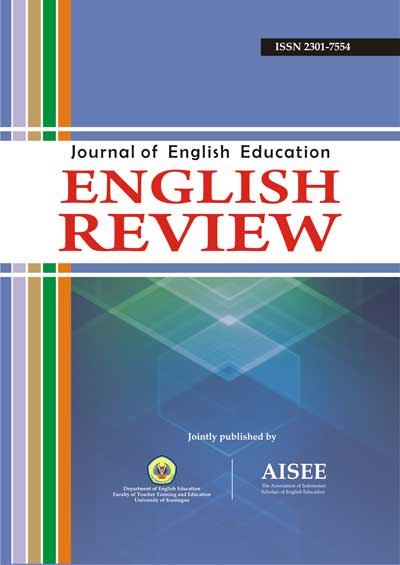BRIDGING THE GAP BETWEENNEEDS ANALYSIS ANDCOURSE EVALUATION INSIGHTS
Abstract
Abstract: The “Advancing English Skillsâ€, textbook was compiled and introduced about a decade ago, at the Faculty of Humanities, Dhaka University, Bangladesh, to teach the foundation English courses, to freshmen students from thirteen departments, including English. Today the course is still being taught at some departments. The department of English scrapped the foundation course, but the textbook is still being used for another compulsory course. This paper presents the ï¬ndings of a study conducted to determine the English language needs of students (60) and teachers (30) at the Humanities Faculty of Dhaka University. Additionally a two prong evaluation of the course and materials from the viewpoints of both students and teachers of the Humanities faculty was carried out, in order to shed light on the nature, effectiveness, and objectives of the course. Strengths and shortcomings of the present course, and areas of mismatch between the students’ needs and the course, were identiï¬ed. Suggestions have been made, to improve the English language courses based on these ï¬ndings, and implications for pedagogy have been highlighted.
Keywords: needs analysis, course evaluation, perceptions, ability, mismatch
References
Akin, A.R., and M. Guceri. (2001). A macro materials evaluation for better or for worse. The Weekly Column, Article 56. Retrieved on 4 November 2006 from http://www.eltnewsletter.com/back/April2001/art562001.htm.
Alam F. (2001). The Dhaka University English curriculum. Revisioning English in Bangladesh, P1-14. UPL.
Banu, R. (1993). A comparative needs analysis: Bangladeshi students at IML and one Japanese student at Georgetown University. Journal of the institute of Modern Languages (ed.).
Basturkmen, H., and A. Al Huneidi (1996). The language needs analysis project at the college of petroleum engineering Kuwait University. ERIC document. Retrieved on 10/11/2008
Chaudhury, T. A. (2011). Identifying the English language needs of humanities students at Dhaka University. Journal of Linguistics, 32-53.
Choudhury S. I. (2001). Rethinking the two Englishes. Revisioning English in Bangladesh, 15-27. UPL
Crystal, D. (2003). English as a global language (2nd ed.). London: Longman
Dudley Evans, T., and M.J. St. John. (1998). Developments in English for specific purposes: a multi-disciplinary approach. Cambridge: Cambridge University Press.
Ellis, R. (1998) Teaching and research: Options in grammar teaching. TESOL Quarterly, 32, 139-60.
Flowerdew, J., and M. Peacock. (2001). The EAP curriculum: issues, methods, and challenges. In Flowerdew, J and Peacock, M. (Eds.) Issues in EAP: A preliminary perspective. UK: Cambridge University Press
Haque, S. M. F., and M. Maniruzaman. (1999). Attitudinal and motivational impact on EFL proficiency of undergraduates: afurther investigation. The Dhaka University Studies, 65-87.
Harvey, D. (1990). The condition of postmodernity. Oxford: Blackwell.
Hossain, M. D. (2012). EAP course design: compromising with learner needs. Research Journal of Commerce and Behavioral Science. 1(6), 7-13.
Hutchinson,T., and A. Waters. (1987). English for specific purposes. Cambridge: Cambridge University Press.
Jordan, R. (1997). English for academic purposes. Cambridge: Cambridge University Press.
Khan, R. (2000). The English foundation course at Dhaka University: an evaluation. The Dhaka University Studies, Part A, 57(1), 77-110.
Kennedy, C. et al. (2001). Sociolinguistics. Birmingham: Centre for English Language studies.
Manivannan, G. (2006). The importance of the English language. Retrieved on April 6, 2009.from http://www.usingenglish.com/teachers/articles/importance-english-language.html.
Munby, J. (1978). Communicative syllabus design. Cambridge: Cambridge University
Press.
Nunan, D. (1999). Second language teaching & learning. Boston: Heinle & Heinle publishers.
Rahman, A. (2007). The history and policy of English education in Bangladesh. In Thehistories and policies of English education in Asia. (Ed) Asia TEFL Series I (205-231) Cobblestone Austin TX
Rea-Dickins, P., and K.P. Germaine. (1998). (Eds) Managing evaluation and innovation in language teaching: building bridges. England: Longman Ltd.
Robinson, P, (1991). ESP today. Hemel Hempstead: Prentice Hall.
Tsui, A. B. M. &J. W. Tollefson. (2007). Language policy and the construction of National Cultural identity. In A. B. M. Tsui & J. W. Tollefson (Eds.) Language, Policy, Culture, and Identity in Asian Contexts. Lawrence Erlbaum Mahwah N.J. 1-24.
Tuckman, B. W. (1985). Evaluating instructional programs. (2nd ed.) Massachusetts, USA: Allyn & Bacon, Inc.
Weir, C. and J. Roberts. (1994). Evaluation in ELT. Oxford, UK: Blackwell Publishers.
Zaman, N., R. Khan, N. Huq, Z. Alam, T. S. Mahboob, and B. S. Sinha (2000) Advancing English skills. Bangladesh: Department of English University of Dhaka.
Zhu, W., and J. Flaitz. (2005). Using focus group methodology to understand International students’ academic needs: a comparison of perspectives. TESL- EJ 8(4).
All articles published in English Review: Journal of English Education (ERJEE) are licensed under the Creative Commons Attribution 4.0 International License (CC BY 4.0).
Copyright Ownership
Authors retain the copyright of their articles and grant ERJEE the right of first publication. The journal is granted a non-exclusive license to publish, reproduce, and distribute the article in any format, medium, or platform, provided that proper credit is given to the original authors.
License Terms – CC BY 4.0
Under the Creative Commons Attribution 4.0 International License, others are free to:
- Share — copy and redistribute the material in any medium or format
- Adapt — remix, transform, and build upon the material for any purpose, even commercially
As long as they:
- Provide appropriate credit to the original author(s) and source
- Provide a link to the license (https://creativecommons.org/licenses/by/4.0/)
- Indicate if any changes were made
There are no restrictions on the reuse, reproduction, or adaptation of published articles as long as attribution is properly given.
Author Warranties
By submitting a manuscript to ERJEE, authors confirm that:
- The work is original and does not infringe any existing copyright.
- The manuscript has not been previously published and is not under consideration elsewhere.
- All sources and references are appropriately acknowledged.
- Necessary permissions have been obtained for any copyrighted materials used.










